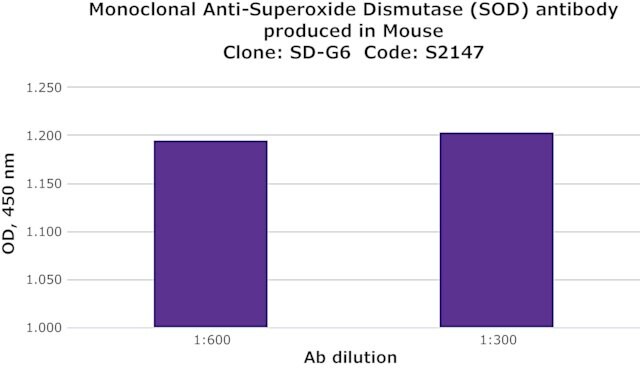您的位置:首页 > 产品中心 > Monoclonal Anti-Superoxide Dismutase (SOD) antibody produced in mouse
Monoclonal Anti-Superoxide Dismutase (SOD) antibody produced in mouse

基本信息
| MDL number | MFCD00164740 |
| NACRES | NA.41 |
| General description【一般描述】 | Superoxide Dismutase (SOD) or CuZn-SOD (SOD1), a cytoplasmic and mitochondrial intermembrane space protein is located on human chromosome 21q22. It belongs to superoxide dismutase multigene family. Monoclonal Anti-Superoxide Dismutase (mouse IgG1 isotype) is derived from the hybridoma produced by the fusion of mouse myeloma cells and splenocytes from an immunized mouse. Superoxide Dismutase (SOD) is a family of metalloenzymes widely distributed in both plants and animals. In mammalian tissues, three types of superoxide dismutase [Cu-Zn-SOD, Mn-SOD, extracellular (EC)-SOD] occur. Human manganese superoxide dismutase (MnSOD), isolated from liver is composed of 22 kDa subunits each containing one Mn atom, while SOD from bovine erythrocyte has a molecular weight of 32.5 kDa. Superoxide Dismutase occurs in high concentrations in brain, liver, heart, erythrocytes and kidney. |
| Specificity【特异性】 | The antibody recognizes natural and recombinant human-Cu-Zn-SOD, human placental SOD, and human erythrocyte SOD using direct capture or competitive ELISA. Cross-reactivity has been observed with human liver and salivary gland, rat salivary gland, pheochromocytoma cell line (PC12), and dog salivary gland. No reactivity was observed with SOD from bovine erythrocytes, kidney, and liver; dog erythrocytes; Bacillus stearothermophilus; E. coli, or horseradish. |
| Immunogen【免疫原】 | recombinant human copper-zinc superoxide dismutase (Cu-Zn-SOD). |
| Application【应用】 | Anti-Superoxide Dismutase (SOD) antibody has been used in immunohistochemistry and Cu-Zn SOD detection via ELISA. |
| Biochem/physiol Actions【生化/生理作用】 | Superoxide Dismutase (SOD) or CuZn-SOD (SOD1) mutations results in amyotrophic lateral sclerosis It acts as a mediator of the HMF (hypomagnetic field) effect. Superoxide Dismutase (SOD) appear to protect cells against reactive free radicals by scavenging the superoxide radicals produced by ionization radiation or through other mechanisms. SOD have been proposed as clinically useful for a wide variety of applications including prevention of oncogenesis, tumor promotion, tumor invasiveness, radiation damage, reduction of the cytotoxic and cardiotoxic effects of anticancer drugs, as a measure against the aging process and as anti-inflammatory agents. |
产品性质
| Quality Level【质量水平】 | 200 |
| biological source【生物来源】 | mouse |
| conjugate【偶联物】 | unconjugated |
| antibody form【抗体形式】 | ascites fluid |
| antibody product type | primary antibodies |
| clone【克隆】 | SD-G6, monoclonal |
| contains【包含】 | 15 mM sodium azide |
| species reactivity | canine, rat, human |
| technique(s) | indirect ELISA: 1:300 |
| isotype【同位素/亚型】 | IgG1 |
| UniProt accession no.【UniProt登记号】 | P00441 |
| shipped in【运输】 | dry ice |
| storage temp.【储存温度】 | −20℃ |
| Gene Information | human ... SOD1(6647) rat ... Sod1(24786) |
产品说明
| Disclaimer【免责声明】 | Unless otherwise stated in our catalog or other company documentation accompanying the product(s), our products are intended for research use only and are not to be used for any other purpose, which includes but is not limited to, unauthorized commercial uses, in vitro diagnostic uses, ex vivo or in vivo therapeutic uses or any type of consumption or application to humans or animals. |
安全信息
| Storage Class Code【储存分类代码】 | 12 - Non Combustible Liquids |
| WGK | WGK 3 |




